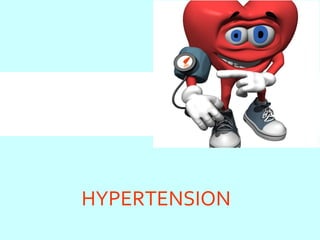
SECONDARY HYPERTENSION
- 1. HYPERTENSION
- 2. Systemic hypertension • long-lasting, usually permanent increase of systolic and diastolic blood pressure primary (essential) hypertension – unknown cause; usually coincidence of more factors – neural, hormonal, kidney dysfunction, ... secondary (symptomatic) hypertension – symptom (sign) of other disease
- 4. essential hypertension – 90 to 95 % of high blood pressure prevalence: • children...about 4 %, mostly secondary • middle age ... 11-21 % • 50-59 years old ... approximately 44 % • 60-69 years old ... approximately 54 % • more than 70 years old ... ≥ 64 % (Standard guidelines, 2nd edition)
- 5. CLASSIFICATION OF HYPERTENSION JNC 7 7th report of Joint National Committee on Prevention, Detection, Evaluation, and Treatment of High Blood Pressure
- 6. CLASSIFICATION OF ADULT´S HYPERTENSION Previous classification of hypertension (JNC 6, WHO)
- 7. REASONS FOR ACTUALISATION OF CLASSIFICATION JNC 6 (1997): Completing of more new clinical studies with substantial consequences for the treatment of hypertension. Need for less complicated classification of hypertension. Need for new and clear guidelines suitable for physicians. Previous reports didn´t bring expected benefits.
- 10. RISK OF CARDIOVASCULAR DISEASES the higher BP, the higher risk of heart failure, stroke, renal diseases each increase of systolic BP by 20 and diastolic BP by 10 mm Hg doubles the risk of CVD
- 14. BENEFIT OF BP REDUCTION In clinical studies was during antihypertensive therapy recorded: 35-40% incidence reduction of stroke 20-25% incidence reduction of myocardial infarction more than 50% share at incidence reduction of heart failure it is assumed that among patients at first stage of hypertension (140-159/90-99 mm Hg) and with other cardiovascular risk factors, permanent reduction of BP by 12 mm Hg during 10 years prevents one death from 11 treated patients (when CVS disease or organ affection, it is one from 9)
- 15. EFFECTIVITY OF BP REDUCTION Despite the fact that decreasing of BP below 140/90 mm Hg is successful among more and more patients, still their number (34%) is less than intention (50%), 30% still doesn´t know about their disease
- 16. EVALUATION OF PATIENTS All of these datas influence the prognosis and therapy selection. Evaluation of patients with diagnosed hypertension has importance to: evaluate the way of living + reveal other CVS risk factors and/or associated diseases
- 17. Very important is the circadian rhythm of blood pressure. Physiological profound nocturnal decline, mostly around 4 a.m. ("dipping"), acts as a protection against pathological lesions of blood vessels, resp. reduces them Hypertensive patients with significant nightime BP decrease have a more favorable prognosis ,as patients whose blood pressure at night compared to daytime values doesn´t decrease (worse prognosis) -→ according to it are patients diveded to „dippers“ versus „non-dippers“ Improvement of diagnosis ← broader application of 24-hour blood pressure monitoring
- 18. Circadian rythm of BP (dippers vs. non-dippers)
- 19. WE GAIN INFORMATION ABOUT PATIENT FROM : Anamnesis Physical examination (BP measurement, eyeground examination, BMI calculation, listening to murmurs at large arteries, detailed examination of heart, lungs, stomach, searching for enlarged kidneys, palpation of glandula thyroidea, resistency and abnormal pulsation of aorta, palpation of lower extremities to search for oedemas and pulsations, neurologic examination) Laboratory examinations (ECG, urine, blood glucose, haematokrit, kallium, calcium, creatin in serum, lipid spectrum of serum)
- 20. TREATMENT The final goal of antihypertensive therapy is reduction of mortality and morbidity to CVS and renal diseases. Primary goal is reduction of systolic BP. We want to reach BP less than 140/90 mm Hg (Torr), or less than 130/80 mm Hg among diabetic patients and patients with kidney diseases Needed is also early detection.
- 22. NONPHARMACOLOGICAL TREATMENT Change of life-style: • intake of salt ... ≤ 5 – 6 g per day • prevention of obesity – dietetic modification • alcohol ... ≤ 30 g per day • smoking – stop • physical activity • psychical relaxation
- 25. PHARMACOLOGIC TREATMENT Antihypertensives 1st choice drugs: 1. diuretics 2. β-blockers 3. inhibitors of ACE 4. blockers of AT1 receptors (ARB) 5. calcium channel blockers 2nd choice drugs – mainly to drug combinations: α1-sympatholytics; α2-sympathomimetics; direct vasodilators; kallium channel openers; agonists of I1 receptors in CNS; other mechanisms of action
- 26. Therapeutic algorithm of hypertension treatment (JNC 7)
